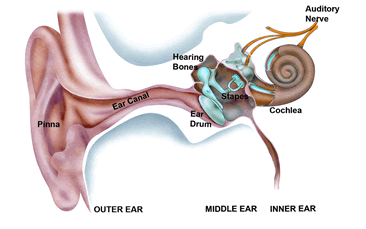How Does My Hearing Work?

Our hearing is made up of four key areas:
Outer ear
This is the part of the ear we can see. It’s called the pinna, and it channels sound into the ear canal down to the ear drum. The ridges and grooves on the pinna play a special role in helping your brain know the direction and source of the sound. Some higher-pitched sounds are also given a boost by the shape of the ear canal. When the sound reaches the eardrum, the first part of the middle ear, it converts the sound into mechanical vibration.
Middle ear
In the middle ear, the ear drum is attached to a chain of three tiny bones – the smallest in the human body. The last of these bones is attached to the oval window, a thin tissue covering an entry point into the fluid-filled inner ear. The chain of middle-ear bones enhances sound through a lever action, transferring the vibration to the inner ear.
Inner ear – the cochlea
The cochlea is a spiral-shaped tube within the skull that contains thousands of tiny sensory cells known as hair cells. These tiny cells rest on a flexible membrane that moves when the oval window vibrates. The outer hair cells boost soft sounds and dampen loud sounds, and the inner hair cells transfer the sound to the auditory nerve.
The auditory nerve converts the sounds into electrical signals that are passed up the auditory pathways in the brain.
The auditory pathway and cortex
The auditory nerve transfers sound information to the brainstem and eventually the auditory cortex in the brain, where the information is processed and interpreted. This is where we decode the sound signals and understand what we are hearing – speech, music, and other sounds.
What can go wrong?
There are several things that can affect our hearing – some of them simple and others complex – and your audiologist or audiometrist will work with you to understand what the issues are and what can be done about them.

